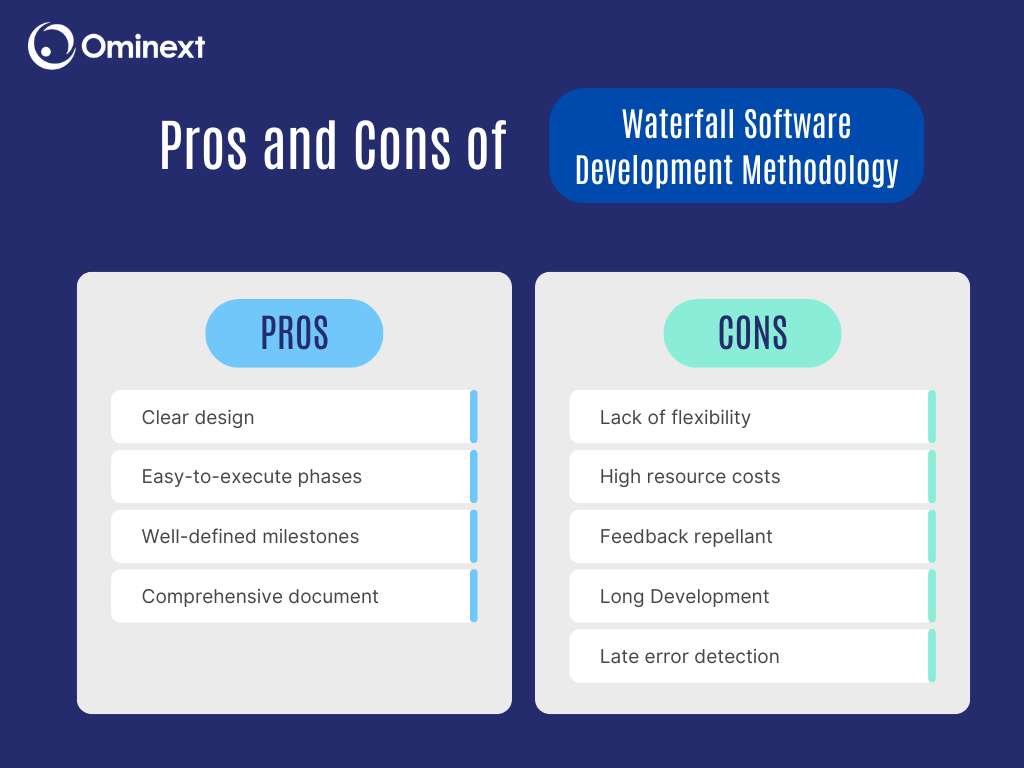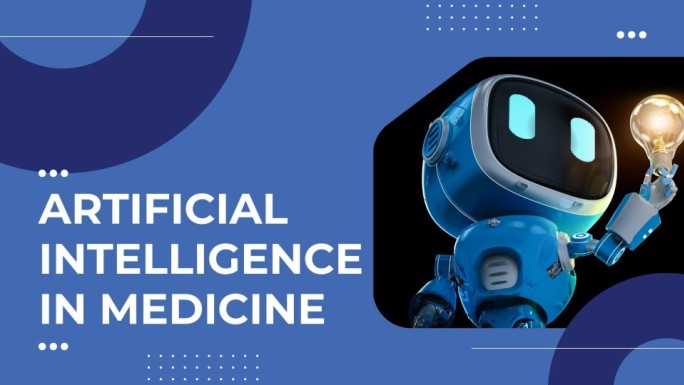The Waterfall Model: A Structured Approach To Software Development
The Waterfall method of software development is one of the oldest and most straightforward approaches in IT engineering. It uses a linear and sequential design to streamline project management, ensuring clarity and efficiency at every phase.
In this blog post, we will delve into the fundamentals of the Waterfall Method, examining its core principles, phases, advantages, and potential drawbacks. We will also discuss why this approach to the software development life cycle is less relevant in today’s landscape.
What is the Software Development Life Cycle Waterfall Model?
The Waterfall methodology in software development is characterized by a sequential approach, where progress flows downwards through a series of distinct and predefined phases, much like a waterfall.
This model emphasizes simplicity and ease of use, which is especially useful for complex and multifaceted projects. However, it leaves little room for changes or iteration once a phase is completed, meaning all requirements must be well-understood from the outset.
The concept of Waterfall methodology was first introduced in a paper by Dr. Winston W. Royce at the Lockheed Software Technology Center. However, he didn’t use the term “waterfall”, but a “downstream” of steps and documentation. Over time, his ideas were formalized and popularly referred to as the "Waterfall Method."
Key Phases of the Waterfall Model
The Waterfall follows a systematic approach with 7 phases. Each phase in the process must be completed before advancing to the next. The 7 phases include:
- Requirements
- Analysis
- Design
- Implementation
- Testing
- Deployment
- Maintenance
#1 Requirements
This is the foundation of the process, focusing on gathering and documenting comprehensive requirements from stakeholders. The requirement phase involves various activities such as interviews, surveys, workshops, and feasibility studies to capture both functional and non-functional requirements.
The aim is to create a detailed specification document, which serves as a reference for all subsequent phases. Key outputs of this phase include the requirements specification document, use cases, and a feasibility report.
#2 Analysis
The Analysis phase examines the details and context in which the software will operate with detailed functional specifications. This phase often includes creating data models, process diagrams, and use case scenarios to ensure a comprehensive understanding of how the system will function.
.jpg)
Key outputs of the Analysis Phase include refined requirement documents, detailed data flow diagrams, entity-relationship diagrams (ERDs), and functional specifications.
#3 Design
In this phase of the Waterfall Model, detailed requirements and analysis are translated into a system architecture and design plan. The project team will create the technical blueprint that guides the development of the software. Key activities include designing the overall system architecture, developing data models, and detailed specifications for each component and module.
Key outputs of the Design phase include system design documents, architectural diagrams, data models, and user interface prototypes. These documents serve as the foundation for the coding phase, ensuring that developers have a clear and precise roadmap to follow.
#4 Implementation
In the Implementation phase, also known as the Coding Phase, developers use detailed guidelines from the Design phase to code the actual software. This phase involves coding, compiling, debugging, and integrating different system components.
Key outputs of the Implementation phase include the source code, compiled executable programs, a minimal viable product, as well as technical documentation. The output program must strictly adhere to the design from the previous phase.
#5 Testing
The Testing Phase in the Waterfall Model verifies that the software meets all requirements through different levels of testing, including unit, integration, system, and user acceptance tests. This phase focuses on identifying and fixing defects to ensure the software’s quality and reliability.
The main outputs of this phase are test plans, test cases, bug reports, and test summary reports, which help to document and track the testing process and defect resolution. By thoroughly testing the software, this phase ensures that the product is robust and reliable, preparing it for successful deployment and use.
#6 Deployment
The deployment phase in the Waterfall model is crucial for transitioning developed software into a production environment. This phase begins with thorough preparation, including setting up the production environment, conducting final tests, and preparing deployment and rollback plans.
During execution, the finalized code is moved to the production environment, which involves configuring necessary settings and migrating data if needed.
Verification follows with smoke testing and User Acceptance Testing (UAT) to ensure the software functions as expected and meets user requirements.
#7 Maintenance
The Maintenance Phase in the Waterfall Model is the final, ongoing stage that begins after the software is deployed to the production environment. This phase focuses on ensuring the software remains functional, secure, and up-to-date over its operational life.
Key activities include fixing bugs that are discovered post-deployment, implementing new features in response to user feedback, and updating the software to adapt to changes in technology or user requirements. The Maintenance Phase ensures updated software versions as well as provides bug fix reports, maintenance logs, and user support documentation.
Features of the Waterfall Software Development Life Cycle
Projects that use the Waterfall model are well-defined, predictable, and heavily reliant on specific documentation. They often have the following characteristics:
- Sequential and Rigid Structure: The Waterfall methodology requires each phase to be completed before the next one begins for maximum efficiency. There is typically no overlapping between phases, meaning little flexibility to accommodate changes. Any major changes in the project will trigger tracing back to the initial stages.
- Document Reliance: Clear and detailed documentation is a must-have at every stage of the Waterfall methodology. This ensures that projects are well-defined, objectives are easy to follow, and all team members are aligned in their efforts.
- Risk Mitigation: The Waterfall model's structured approach facilitates early risk identification and effective issue management. Each phase undergoes strict documentation and review processes, helping to uncover and address potential risks early.
- High Effort Investment: The Waterfall model needs time and resources to shine. Each phase requires comprehensive documentation, which demands significant effort from the project team. This meticulous approach ensures clarity and quality but may lead to inefficiencies, especially if project requirements change or evolve.
Pros and Cons of the Waterfall Software Development Methodology
The strengths and weaknesses of the Waterfall methodology are as clear as its well-defined structure. Below is a better look into the pros and cons of this approach to software development.
Pros
While not as popular in today’s landscape, the Waterfall methodology still offers powerful benefits such as:
- Clear design: Waterfall is super organized, breaking down the project into clear, focused stages. This makes it easier for the team to understand their specific tasks and responsibilities.
- Easy-to-execute phases: The phase-wise approach simplifies project management by breaking down the project into manageable sections. Since phases are executed in sequence, it’s easier to predict timelines, costs, and resource requirements.
- Well-defined expectations and milestones: Clear milestones and deliverables for each phase ensure that progress can be easily monitored and measured.
- Comprehensive document: Detailed documentation at every stage of the project provides a valuable reference for future maintenance and enhancements. Complete documentation facilitates easier knowledge transfer to new team members or other stakeholders.

Cons
Compared to the Agile methodology, the Waterfall model suffers from several shortcomings. These include:
- Lack of flexibility: The Waterfall model is very linear, meaning once you finish a phase, it's tough to go back and make changes without disrupting the entire project. This rigidity can be a big drawback if requirements change mid-project.
- High resource costs: The Waterfall methodology relies on extensive documentation, which takes a lot of time and effort. Addressing any defects will also cost resources because changes are hard to implement after a phase is completed.
- Feedback repellant: Waterfall tends to push user feedback to the very end, during testing. This means that you might find out too late that the product doesn’t meet user needs or expectations, requiring significant rework.
- Long Development: Since you have to complete each phase fully before moving on to the next, Waterfall projects can take a long time to finish. This is especially problematic for fast-paced industries where being first to market can be crucial.
- Late error detection: By the time you start testing, a lot of development has already been done. If errors or issues are discovered at this late stage, fixing them can be a major hassle, often necessitating a return to earlier phases.
Agile vs. Waterfall Methodology in Software Development
The Agile model has been widely adopted in software development today. Born out of the need for a more flexible and responsive approach to project management, Agile emphasizes iterative progress, continual feedback, and the ability to adapt to change.
Unlike the traditional Waterfall method, which follows a linear and sequential process, Agile breaks the project into manageable units known as sprints or iterations. Each sprint delivers a potentially shippable product increment, allowing teams to quickly adapt to evolving requirements and stakeholder feedback.
Let’s see how these two fundamentally different approaches to software development methodology “stack up” against each other!
|
Key Criteria |
Waterfall Model |
Agile Model |
|
Project Structure and Approach |
Follows a linear, sequential approach with distinct phases like Requirement, Design, Implementation, Verification, and Maintenance. Each phase must be completed before the next begins. |
Embraces an iterative and incremental approach. Work is divided into short cycles or sprints, allowing for ongoing revisions and continuous delivery of small, functional increments of the software. |
|
Flexibility and Adaptability |
Highly rigid and less adaptable to changes. Once a phase is completed, it is difficult and costly to go back and make changes. |
Highly flexible and adaptive. Changes and new requirements can be incorporated at almost any stage of the development process, making it ideal for projects with evolving requirements. |
|
Customer Involvement and Feedback |
Limited customer involvement, primarily at the beginning (during requirements gathering) and at the end (during testing and delivery). This can sometimes result in a product that doesn't fully meet user needs. |
Encourages regular and continuous customer involvement through frequent feedback loops. This ensures that the product aligns more closely with user needs and expectations. |
|
Testing and Quality Assurance |
Testing is deferred until after the development phase is complete, which can lead to the late discovery of errors and issues. |
Involves continuous testing and quality assurance throughout the development cycle, allowing for early detection and resolution of errors, resulting in higher-quality software. |
|
Documentation and Planning |
Emphasizes comprehensive documentation and detailed upfront planning. This provides a clear and well-defined project roadmap but can make the process less responsive to change. |
Focuses on minimal but essential documentation, prioritizing working software and adaptive planning over exhaustive documentation. This allows for more flexibility but may lack the detailed roadmap that Waterfall provides. |
Why is the Waterfall Model Not as Popular in the Modern Software Development Landscape?
The “Achilles' heels” of the Waterfall approach is its lack of flexibility.
The Waterfall model, once the industry standard for software development services, has seen a decline in popularity in today's rapidly evolving tech landscape. One of the primary reasons for this shift is the model's inherent rigidity.
The linear, sequential nature of Waterfall means that once a phase is completed, it’s difficult—and often costly—to go back and make changes. This lack of adaptability significantly impacts its application in a world where requirements can change rapidly.
Additionally, the Waterfall approach isn’t the fastest at detecting issues. Fixing errors are problems at later stages. Critical defects may even trigger a project-wise reset, sending everyone back to the drawing board. That’s a big obstacle in modern settings.
Extended development cycles also push back the popularity of Waterfall. Nowadays, software development often demands quick releases and a faster time-to-market, something Waterfall struggles to provide.
Said demand for rapid innovation and adaptation to frequent changes, user engagement, and quick feedback loops have made Agile methodologies far more suitable for today’s development environment. While Waterfall still has its place in projects with well-defined, unchanging requirements, it has largely been overshadowed by more flexible and adaptive approaches that better align with the fast-paced, dynamic nature of modern software development.
Should You Use the Waterfall Methodology for Your Project?
The popularity of the Waterfall model has regressed in the last few decades. According to research by Zippia, about 71% of U.S. companies are now using Agile. with a 64% success rate. Meanwhile, projects under the competing Waterfall methodology only have a 49% success rate.
However, it’s not saying that the Waterfall model is completely irrelevant in this day and age. There are still scenarios where using Waterfall can be advantageous. Let’s take a look!
Well-understood Requirements
In situations where project requirements are precise, reliable, and thoroughly documented from the beginning, the Waterfall model shines. Since this methodology follows a linear progression, having a solid grasp of all requirements upfront ensures that each phase can be planned meticulously without worrying about mid-project surprises.
Very Little Changes Expected
If the scope of the project is unlikely to change during development, Waterfall is an ideal choice. It thrives in environments where requirements are stable, and very few adjustments or expansions are anticipated once development begins.
Predictable Projects
Waterfall is well-suited for projects that are predictable and low-risk with known, controllable hazards. Being able to address risks and challenges early in the development lifecycle adds a layer of security and ensures a more streamlined development process.
That means Waterfall can be quite effective in small to medium-sized projects with a clear development path and lower complexity.
Regulatory Compliance is Critical
In industries where regulatory compliance and documentation are paramount, such as healthcare, finance, and government, Waterfall's emphasis on comprehensive documentation is a significant advantage. The detailed records produced through each phase can be invaluable for meeting stringent regulatory requirements.
Limited Resources
Projects with limited resources, in terms of both time and budget, can benefit from Waterfall's structured approach. By defining and sticking to a clear plan from the outset, resource allocation can be more targeted and efficient, reducing wastage and ensuring that the available resources are used effectively.
Wrapping Up!
While Agile may be the star of modern engineering, the Waterfall method of software development still holds its own in certain scenarios. Its clear, structured approach is invaluable for projects with well-defined requirements and minimal expected changes. For industries that demand thorough documentation and regulatory compliance, Waterfall’s step-by-step process is a perfect fit.
Though it may lack the flexibility of newer methodologies, Waterfall’s predictability, and straightforward nature can make it the best choice for specific types of projects. By understanding its strengths and limitations, you can decide when Waterfall is the right tool for the job, ensuring your projects are both well-managed and successful. Don't discount it just yet; there’s still room for Waterfall in the world of software development.





